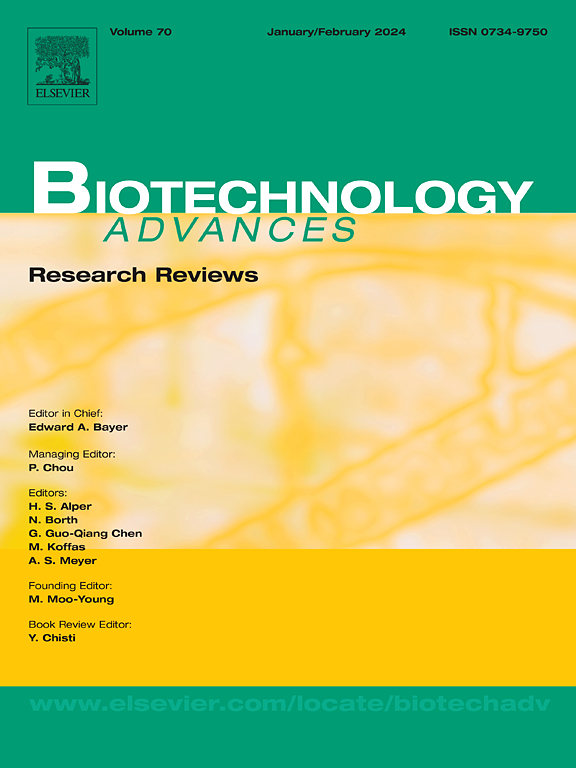Guidelines toward ecologically-informed bioprospecting for microbial plastic degradation
IF 12.1
1区 工程技术
Q1 BIOTECHNOLOGY & APPLIED MICROBIOLOGY
引用次数: 0
Abstract
Biological degradation of plastics by microbial enzymes offers a sustainable alternative to traditional waste management methods that often pollute the environment. This review explores ecologically-informed bioprospecting for microorganisms possessing enzymes suitable for biological plastic waste treatment. Natural habitats enriched in plastic-like polymers, such as insect-derived polyesters, epicuticular microbial biofilms in the phyllosphere of plants in extreme environments, or aquatic ecosystems, are highlighted as promising reservoirs for bioprospecting. Anthropogenic habitats, including plastic-polluted soils and the plastisphere, have yielded potent enzymes such as PETases and cutinases, which are being exploited in biotechnology. However, bioprospecting in plastispheres and artificial environments frequently leads to the isolation of environmental opportunistic microorganisms, such as Pseudomonas aeruginosa, Aspergillus fumigatus, Parengyodontium album, or species of Fusarium, which are capable of becoming human and/or plant pathogens. These cases necessitate stringent biosecurity measures, including accurate molecular identification, ecological assessment, and containment protocols. Beyond advancing bioprospecting approaches toward a broader scope of relevant habitats, this review underscores the educational value of such screenings, specifically, in understudied natural habitats, emphasizing its potential to uncover novel enzymes and microorganisms and engage the next generation of researchers in interdisciplinary study integrating environmental microbiology, molecular biology, enzymology, polymer chemistry, and bioinformatics. Finally, we offer guidelines for microbial bioprospecting in various laboratory settings, ranging from standard environmental microbiology facilities to high-biosecurity facilities, thereby maximizing the diversity of scientists who may contribute to addressing urgent environmental challenges associated with plastic waste.
微生物塑料降解的生态知情生物勘探指南
利用微生物酶对塑料进行生物降解,为经常污染环境的传统废物管理方法提供了一种可持续的替代方法。本文综述了具有适合生物塑料废物处理的酶的微生物的生态学生物勘探。富含类塑料聚合物的自然栖息地,如昆虫衍生的聚酯、极端环境下植物层状圈的表皮微生物生物膜或水生生态系统,被认为是生物勘探的有希望的储层。人为的生境,包括受塑料污染的土壤和塑料圈,产生了强效酶,如petase和角质酶,这些酶正在生物技术中加以利用。然而,在塑料球和人工环境中的生物勘探经常导致环境条件微生物的分离,如铜绿假单胞菌、烟曲霉、Parengyodontium album或镰刀菌,它们能够成为人类和/或植物病原体。这些病例需要严格的生物安全措施,包括准确的分子鉴定、生态评估和控制方案。除了将生物勘探方法推进到更广泛的相关栖息地之外,本综述强调了这种筛选的教育价值,特别是在研究不足的自然栖息地,强调其发现新酶和微生物的潜力,并吸引下一代研究人员进行环境微生物学,分子生物学,酶学,聚合物化学和生物信息学的跨学科研究。最后,我们提供了在各种实验室环境下的微生物生物勘探指南,从标准的环境微生物设施到高生物安全设施,从而最大限度地提高科学家的多样性,他们可能有助于解决与塑料废物相关的紧迫环境挑战。
本文章由计算机程序翻译,如有差异,请以英文原文为准。
求助全文
约1分钟内获得全文
求助全文
来源期刊

Biotechnology advances
工程技术-生物工程与应用微生物
CiteScore
25.50
自引率
2.50%
发文量
167
审稿时长
37 days
期刊介绍:
Biotechnology Advances is a comprehensive review journal that covers all aspects of the multidisciplinary field of biotechnology. The journal focuses on biotechnology principles and their applications in various industries, agriculture, medicine, environmental concerns, and regulatory issues. It publishes authoritative articles that highlight current developments and future trends in the field of biotechnology. The journal invites submissions of manuscripts that are relevant and appropriate. It targets a wide audience, including scientists, engineers, students, instructors, researchers, practitioners, managers, governments, and other stakeholders in the field. Additionally, special issues are published based on selected presentations from recent relevant conferences in collaboration with the organizations hosting those conferences.
 求助内容:
求助内容: 应助结果提醒方式:
应助结果提醒方式:


